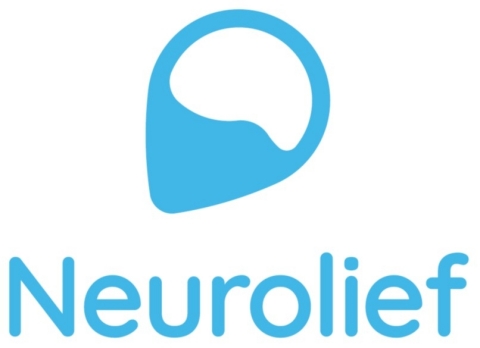PHILADELPHIA & NETANYA, Israel--(BUSINESS WIRE)--Neurolief, a developer of next-generation digital therapeutics brain neuromodulation technology, today announced that findings of a clinical study evaluating the efficacy and safety of the Relivion™, the first non-invasive combined occipital and trigeminal nerve stimulation system for treating migraine, will be presented at the American Headache Society (AHS) 2019 Annual Meeting in Philadelphia this week.
The presentation, “First Non-Invasive Combined Occipital & Trigeminal Nerve Stimulation Digital Therapeutics System for Treatment of Migraine: A Randomized, Sham-Controlled, Double-Blind Clinical Trial,” will take place Saturday, July 13, on day three of the 61st annual scientific meeting. The session comes on the heels of Neurolief being granted CE Mark for the Relivion, which allows the company to market, sell and distribute the Relivion system as an over-the-counter therapy within the European Union and countries that participate with Agreements on Mutual Recognition of Conformity Assessment.
The Relivion is the first non-invasive, adaptive multi-channel brain neuromodulation technology that offers a highly effective therapy for treating neurological and neuropsychiatric disorders, without the risks and costs associated with invasive procedures and without the side effects or contra-indications related to medications. For migraine treatment, combined neuromodulation of the trigeminal and occipital nerves was previously possible only with implanted devices. The Relivion system is simple and safe for patients to self-administer at home at a fraction of the cost of surgical implants.
Leveraged to secure the CE Mark, the prospective, randomized, double-blind, parallel-group, sham controlled clinical investigation evaluated the clinical performance and safety of self-administered treatment for migraine using combined occipital and trigeminal neuromodulation (Neurolief Relivion™). The study randomly divided 55 migraine sufferers into two groups, with one group receiving neuromodulation by way of electrical stimulation and a control group receiving sham neuromodulation. The sham group received electrical stimulation that feels similar to the actual treatment but is inadequate to produce a clinically meaningful effect.
Two hours after initiation of treatment, 76 percent of the subjects in the treatment group reached headache relief compared to only 31 percent in the control group. Additionally, 43 percent of treated subjects who experienced a severe or moderate level of pain before treatment reported being pain-free two hours after initiation of treatment, compared to less than 11 percent of subjects in the control group. No subjects reported any serious adverse events during the study. The investigators hypothesized that the synergistic neuromodulatory effect elicited by concurrent activation of the occipital and trigeminal neural pathways contributed to the outstanding therapeutic outcomes shown in the study.
“The results of this study are promising for those seeking a non-invasive, drug-free therapy for migraine, with treated subjects receiving significant pain reduction,” said Stewart J. Tepper MD, professor of Neurology at the Geisel School of Medicine at Dartmouth, who will present the results at AHS. “The Relivion is a comfortable, non-invasive wearable therapy that can be self-administered. More importantly, it comes without side effects or contra-indications associated with medication, targets the major neural pathways responsible for migraine pain, and can learn to deliver personalized treatment to individuals to better treat acute migraine attacks.”
Neurolief’s Relivion is comprised of a comfortable and adjustable electronic headset that provides precise modulated pulses simultaneously to six branches of the occipital and trigeminal nerves via several adaptive output channels around the patient’s head. The occipital and trigeminal nerves then conduct the stimulation directly to the brainstem (Trigemino-Cervical Complex –TCC). Prior and existing non-invasive neuromodulation devices for treatment of migraine stimulate only the trigeminal nerve, treating only part of the brain that triggers migraine. In contrast, the Relivion also modulates the occipital nerves, where the majority of migraines originate. In addition, the sophisticated cloud-enabled system connects to a proprietary mobile phone app that learns over time and in the future will deliver optimized personalized treatment for each patient.
“We are encouraged that the results of this study suggest that the Relivion, and particularly its digital therapeutics ecosystem that adapts and personalizes treatment for each patient, will soon become a disruptive neurological therapy,” said Shmuel Shany, co-founder and CEO, Neurolief. “We know that migraine sufferers are looking for a smart, non-invasive, drug-free way to better treat their migraine attacks, so they can get back to their lives and be productive more quickly.”
About Migraine
Migraine is a prevalent and debilitating primary headache disorder that affects approximately 12 percent of the population worldwide. The World Health Organization (WHO) estimates that 324 million people worldwide have migraine. It is the most prevalent pain condition, prompting loss of productivity with an estimated economic annual burden of over €27 billion in European Union countries.1 The economic burden of migraines in the United States was estimated at $36 billion in 2016.2
Migraine patients suffer from disabling symptoms that usually consist of a moderate to severe headache lasting four to 72 hours, nausea and/or vomiting, phonophobia (intolerance to noise) and photophobia (intolerance to light). Seventy-five percent have a reduced ability to function during the migraine episodes, and 33 percent require bed rest during their attacks.3 There is currently no cure for migraines, and over-the-counter medications often do not work. Patients with migraine are often refractory to medical treatment, and some of the most effective antimigraine drugs such as Triptans have substantial side effects.4
About Neurolief
Neurolief is a digital therapeutics company developing proprietary brain neuromodulation technology to treat neurological and neuropsychiatric disorders such as migraine and depression. The company’s breakthrough products either complement or provide an alternative to pharmaceutical therapies, which are often associated with potential short and long-term adverse effects. Delivered via electronic headsets, Neurolief’s digital therapies are designed to concurrently neuromodulate major neural pathways in the head and thereby affect brain regions that are involved in control and modulation of pain and mood. The systems are intended to provide a highly effective, safe and side effect free treatment for hundreds of millions of patients worldwide. Future indications for Neurolief’s technology include depression, insomnia, ADHD and additional chronic pain and neuropsychiatric disorders. For more information, please visit www.neurolief.com.
1 Stovener, Lars J, and Andrée, Colette, Impact of headache in Europe: A review for the Eurolight project. The Journal of Headache and Pain, 2008. https://www.researchgate.net/publication/5433227
2 Bonafede, M., et al., Study Summary: Costs Associated With Migraine in the United States. AJCM, 2018. https://www.ajmc.com/compendium/migraine/study-summary-costs-associated-with-migraine-in-the-united-states
3 Lipton, R.B., et al., Migraine prevalence, disease burden, and the need for preventive therapy. Neurology, 2007. 68(5): p. 343-9.
4 Loder, E., Triptan therapy in migraine. New England Journal of Medicine, 2010. 363(1): p. 63-70.




